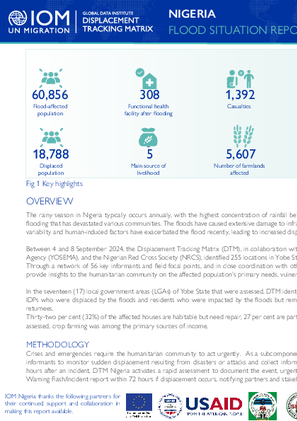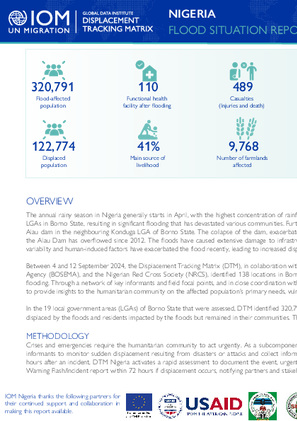-
Countries
-
Data and Analysis
-
Special Focus
-
Crisis Responses
Internal displacement
Domain host
displacement.iom.int

Contact
DTM Nigeria, iomnigeriadtm@iom.int
Language
English
Location
Nigeria
Period Covered
Sep 04 2024
Sep 08 2024
Activity
- Mobility Tracking
- Event Tracking
The rainy season in Nigeria typically occurs annually, with the highest concentration of rainfall between June and September. Many states have been impacted by hefty rains, resulting in significant flooding that has devastated various communities. The floods have caused extensive damage to infrastructure, crops, and shelters, severely affecting livelihoods and displacing many households. Climate variability and human-induced factors have exacerbated the flood recently, leading to increased displacement across Nigeria.
In the seventeen (17) local government areas (LGAs) of Yobe State that were assessed, DTM identified 60,856 individuals in 13,474 households affected by the floods. These individuals included both IDPs who were displaced by the floods and residents who were impacted by the floods but remained in their communities. The affected population included 18,788 displaced individuals and 567 returnees.
Thirty-two per cent (32%) of the affected houses are habitable but need repair, 27 per cent are partially damaged but need repairs, and 17 per cent are destroyed. In 75 per cent (75%) of the locations assessed, crop farming was among the primary sources of income.

Contact
DTM Nigeria, iomnigeriadtm@iom.int
Language
English
Location
Nigeria
Period Covered
Sep 04 2024
Sep 08 2024
Activity
- Mobility Tracking
- Event Tracking
The annual rainy season in Nigeria occurs from April to October with the highest concentration of rainfall. During July-August 2024, many states nationwide were impacted by hefty rains, resulting in significant flooding that devastated various communities. The floods caused extensive damage to infrastructure, crops, and shelters, severely affecting livelihoods and displacing many households. Climate variability and human-induced factors have exacerbated the flood recently, leading to increased displacement across Nigeria.
In the 20 local government areas (LGAs) of Jigawa State that were assessed, DTM identified 257,236 individuals in 42,603 households affected by the floods. These individuals included IDPs who were displaced by the floods and residents who were impacted by the floods but remained in their communities. The affected population included 94,893 displaced individuals.
Thirty-six per cent (36%) of the affected houses are habitable but need repair, forty-six per cent were partially damaged but need repairs, and 18 per cent were destroyed. In 96 per cent (96%) of the locations assessed, crop farming was among the primary sources of income.c

Contact
DTM Nigeria, iomnigeriadtm@iom.int
Language
English
Location
Nigeria
Period Covered
Sep 04 2024
Sep 12 2024
Activity
- Mobility Tracking
- Event Tracking
The annual rainy season in Nigeria generally starts in April, with the highest concentration of rainfall between June and September. Between August and September 2024, hefty rains affected many LGAs in Borno State, resulting in significant flooding that has devastated various communities. Furthermore, on 9 September 2024, Maiduguri was affected by a massive flood due to the collapse of Alau dam in the neighbouring Konduga LGA of Borno State. The collapse of the dam, exacerbated the flooding in Maiduguri in addition to the continuous heavy rainfall. This marks the first time the Alau Dam has overflowed since 2012. The floods have caused extensive damage to infrastructure, crops, and shelters, severely affecting livelihoods and displacing many households. Climate variability and human-induced factors have exacerbated the flood recently, leading to increased displacement across Nigeria.
In the 19 local government areas (LGAs) of Borno State that were assessed, DTM identified 320,791 individuals in 65,731 households affected by the floods. These individuals included IDPs displaced by the floods and residents impacted by the floods but remained in their communities. The affected population included 157,274 displaced individuals and 108 returnees.
Contact
dtmlebanon@iom.int
Location
Lebanon
Activity
- Mobility Tracking
- Baseline Assessment
Period Covered
Oct 10 2023 -Sep 03 2024
Since October 8 there has been an increase in cross-border incidents between Israel and Lebanon, resulting in the displacement of people both within the South and elsewhere within the country. Since October 10, the Displacement Tracking Matrix (DTM) has been conducting the daily monitoring of population movements. The objective of the exercise is to inform preparedness and response planning.
Aggregated data is available through the DTM API: https://dtm.iom.int/data-and-analysis/dtm-api
A more detailed version of this dataset is available, to get access kindly click on the 'Request Access' button
Population Groups
IDPs
Returnee (Previously Internally Displaced)
Survey Methodology
Unit of Analysis Or Observation
Admin Area 2
Admin Area 3
Household
Individual
Type of Survey or Assessment
Keywords
Geographical Scope Full Coverage
Administrative boundaries with available data
The current dataset covers the following administrative boundaries
Contact
DTMSudan@iom.int
Location
Sudan
Activity
- Mobility Tracking
- Baseline Assessment
Period Covered
Jul 01 2024 -Aug 27 2024
- DTM Sudan estimates that 10,834,382 individuals (2,186,855 households) are currently displaced in Sudan, as of 27 August 2024.
- An estimated 8,066,827 individuals were displaced since 15 April 2023.
- An estimated 2,344,904 individuals crossed borders into neighbouring countries since 15 April 2023.
A more detailed version of this dataset is available, to get access kindly click on the 'Request Access' button
Population Groups
IDPs
Survey Methodology
Unit of Analysis Or Observation
Admin Area 2
Household
Individual
Type of Survey or Assessment
Key Informant
Keywords
Geographical Scope Full Coverage
Administrative boundaries with available data
The current dataset covers the following administrative boundaries

Contact
dtmlebanon@iom.int
Language
English
Location
Lebanon
Period Covered
Oct 10 2023
Sep 10 2024
Activity
- Mobility Tracking
- Baseline Assessment
Since October 8 there has been an increase in cross-border incidents between Israel and Lebanon, resulting in the displacement of people both within the South and elsewhere within the country. Since October 10, the Displacement Tracking Matrix (DTM) has been conducting the daily monitoring of population movements. The objective of the exercise is to inform preparedness and response planning.

Contact
DTMBurundi@iom.int
Language
English
Location
Burundi
Period Covered
May 03 2024
May 17 2024
Activity
- Site Assessment
DTM identified 76,987 Internally Displaced Persons (IDPs) in 102,824 displaced households in the 18 provinces of Burundi during the month of May 2024. Among those identified, 93 per cent were displaced due to environment-related disasters while 7 per cent were a result of other reasons. Over half (54%) of IDPs were children, aged 18 years old and under.
Contact
mtmtajikistan@iom.int
Location
Tajikistan
Activity
- Mobility Tracking
Period Covered
May 01 2024 -May 31 2024
This assessment covered 948 communities through focus group discussions with 3,288 key informants. Based on the key informants' estimates, 1,060 international migrant workers were hosted in the assessed communities in Tajikistan during 2020 and April 2024. Concurrently, 3,371 internal migrants were hosted in the assessed communities and 274,333 Tajik nationals were reported to be residing abroad as international migrants. In addition, 334,299 return migrants returned from abroad.
Population Groups
Migrants Present
Survey Methodology
Unit of Analysis Or Observation
Admin Area 2
Admin Area 3
Site or Location
Type of Survey or Assessment
Key Informant
Keywords
Geographical Scope Full Coverage
Administrative boundaries with available data
The current dataset covers the following administrative boundaries
The Central Sahel area, and in particular the Liptako Gourma region, which borders Burkina Faso, Mali and Niger, is affected by a complex crisis involving growing competition over dwindling resources; climatic variability; demographic pressure; high levels of poverty; disaffection and a lack of livelihood opportunities; communal tensions; the absence of state institutions and basic services; and violence related to organized crime and non-state armed groups. The crisis has triggered significant displacement of populations in the concerned countries and is affecting neighbouring countries such as Mauritania and the coastal countries.
As of August 2024, 3,150,710 individuals have been displaced, including 2,616,570 internally displaced persons (83% of the displaced population) and 534,140 refugees (17% of the displaced population). Sixty-seven per cent of the displaced populations (2,101,935 individuals) were located in Burkina Faso, while 14 per cent resided in Mali (422,029 individuals), 11 per cent in Niger (351,560 individuals) and 4 per cent in Mauritania (136,954 individuals). The crisis’ recent spill over to coastal countries, namely Côte d’Ivoire, Ghana, Togo and Benin, shows growing number of refugees coming from the Central Sahel and populations internally displaced. As of August, 138,232 individuals were affected by displacement within the four countries (25,852 in Benin, 58,079 in Côte d’Ivoire, 7,242 in Ghana and 47,059 in Togo) of which 34,088 were internally displaced.
The crisis currently affecting the Lake Chad Basin states results from a complex combination of factors, including conflict with non-state armed groups, extreme poverty, underdevelopment and a changing climate, which together have triggered significant displacement of populations.
As of August 2024, Cameroon, Chad, Niger and Nigeria were hosting an estimated 6,067,908 affected individuals made up of internally displaced persons (IDPs), returnees (former IDPs and returnees from abroad) and refugees (both in- and out-of-camp). Thirteen per cent of the affected population (777,656 individuals) were located in Cameroon, while 5 per cent resided in Chad (294,965 individuals), 9 per cent in Niger (558,416 individuals) and finally, 74 per cent in Nigeria (4,436,871 individuals). Overall, the numbers show a sharp increase in returnees from abroad (+45%) and sight decreases in IDPs (-1%), returnees former IDPs (-5%) and refugees (-1%) since December 2023.
Pagination
- Previous page
- Page 33
- Next page


